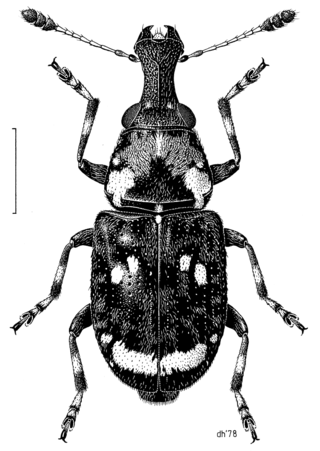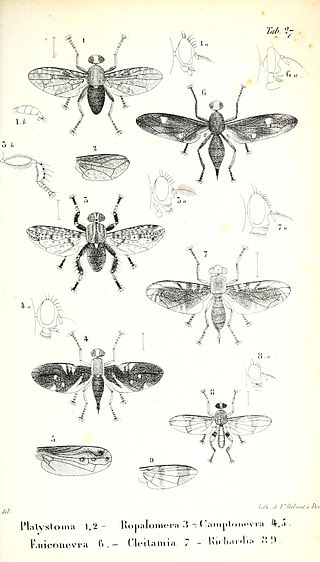
Jasmine is a genus of shrubs and vines in the olive family of Oleaceae. It contains around 200 species native to tropical and warm temperate regions of Eurasia, Africa, and Oceania. Jasmines are widely cultivated for the characteristic fragrance of their flowers. Additionally a number of unrelated species of plants or flowers contain the word "jasmine" in their common names.

Corixidae is a family of aquatic insects in the order Hemiptera. They are found worldwide in virtually any freshwater habitat and a few species live in saline water. There are about 500 known species worldwide, in 55 genera, including the genus Sigara.

Anthribidae is a family of beetles also known as fungus weevils. The antennae are not elbowed, may occasionally be longer than the body and thread-like, and can be the longest of any members of Curculionoidea. As in the Nemonychidae, the labrum appears as a separate segment to the clypeus, and the maxillary palps are long and projecting.
The National Biodiversity Network (UK) (NBN) is a collaborative venture set up in 2000 in the United Kingdom committed to making biodiversity information available through various media, including on the internet via the NBN Atlas—the data search website of the NBN.

Caeciliusidae is a family of Psocodea belonging to the suborder Psocomorpha. The family was once named Caeciliidae, but the latter name was changed because of homonymy with the amphibian family Caeciliidae. The subfamily Paracaeciliinae was formerly in Caeciliusidae, but it has been elevated to family rank, Paracaeciliidae.

Polar Bear Pass, is a 262,400 hectare wetland and mountain pass on Bathurst Island within the Qikiqtaaluk Region, Nunavut, Canada. The pass is on federal Crown land.
The World Register of Marine Species (WoRMS) is a taxonomic database that aims to provide an authoritative and comprehensive list of names of marine organisms.

Artace is a genus of moths in the family Lasiocampidae. The genus was erected by Francis Walker in 1855.

Oberea is a genus of longhorn beetles, most of which are stem borers of various plants, including blackberries and their relatives.

Clivina is a genus of ground beetle native to the Palearctic, the Nearctic, the Near East and North Africa. There are more than 600 described species in Clivina.

Eupithecia pygmaeata, the marsh pug, is a moth of the family Geometridae. It is known from most of Europe, western and southern Siberia, the Russian Far East, northern Mongolia and North America .The species primarily colonizes floodplain and disused forests, bogs, river banks and marshy meadows. E. pygmaeata reaches up to 1800 meters in South Tyrol.

The Ropalomeridae are a family of acalyptrate flies.

iNaturalist is an American 501(c)(3) nonprofit social network of naturalists, citizen scientists, and biologists built on the concept of mapping and sharing observations of biodiversity across the globe. iNaturalist may be accessed via its website or from its mobile applications. iNaturalist includes an automated species identification tool, and users further assist each other in identifying organisms from photographs and even sound recordings. As of 9 July 2024, iNaturalist users had contributed approximately 197,660,888 observations of plants, animals, fungi, and other organisms worldwide, and 290,007 users were active in the previous 30 days.

Schizopteridae is the largest family in the infraorder Dipsocoromorpha and comprises 56 genera and approximately 255 species. Schizopterids are some of the smallest (0.5–2.0 mm) true bugs. Members of this family can be distinguished by their small size, enlarged forecoxae and varying degree of abdominal and genitalic asymmetry in males. Schizopteridae exhibit a wide range of simple and complex wing venation patterns. The group is currently divided into three subfamilies: Schizopterinae, Ogeriinae and Hypselosomatinae.
Plants of the World Online (POWO) is an online database published by the Royal Botanic Gardens, Kew. It was launched in March 2017 with the ultimate aim being "to enable users to access information on all the world's known seed-bearing plants by 2020". This was Kew's answer to the "2020 target 1" of the Convention on Biological Diversity (CBD): "an online flora for all known plants."
Sciophilinae is a subfamily of fungus gnats. There are at least 40 genera and 340 described species in Sciophilinae.

Mycetophilinae is a subfamily of fungus gnats in the family Mycetophilidae. There are more than 30 genera and 2,000 described species in Mycetophilinae. There are two tribes, Exechiini and Mycetophilini.
Eudicrana is a genus of fungus gnats in the family Mycetophilidae. There are about 13 described species in Eudicrana.
Animal Ethics is a nonprofit organization formed to promote discussion and debate around issues in animal ethics and to provide information and resources for animal advocates. They also do outreach work in several countries on the issue of speciesism. Their aim is to create a world where moral consideration is extended to all sentient beings. The organization's website covers topics such as speciesism, sentience, veganism and wild animal suffering and has content translated into several languages.













